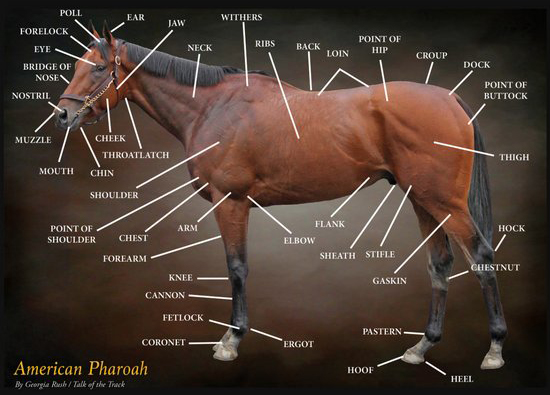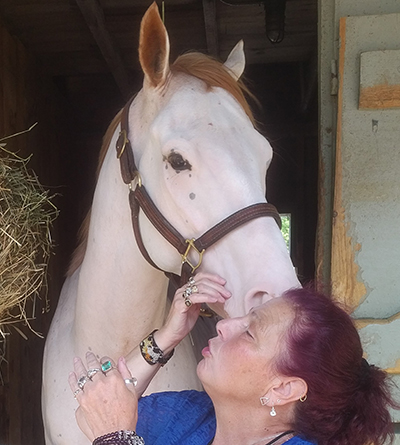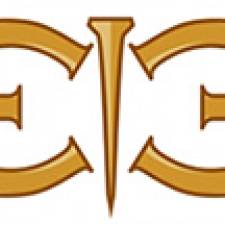
by Marion E. Altieri
When buyers of Thoroughbreds consider a horse for purchase, one of the key considerations is conformation. Conformation is the way a horse is physically put together. The bones, muscles and proportions of the animal are the characteristics that ultimately prepare them for their job—that of running quickly with great efficiency. Human beauty is relative—every culture and every individual has standards of beauty that may not jive with those of anyone else.
Everyone is beautiful to somebody.
This is not the case in the equine world: each breed has standards of beauty. That beauty is not superficial, but rather tied directly at the unconscious level to expectations for the jobs of horses within said breed. Draft horses work hard for a living: they are stocky and muscular, with thick legs and strong backs. Thoroughbreds must be able to run fast, with grace, for grace of movement actually is a factor in the science of winning races. Long, elegant strides are the domain of those who win purses, while jackrabbit runners are far-less likely to take the day. This is a most egalitarian concept: a Thoroughbred doesn't win a race because s/he is liked better by the stewards or race announcer. No one votes on who should win—or the Triple Crown would be achieved every year.
A Thoroughbred must cross the finish line first to win a race.
And just as Fasig-Tipton's elegant, renovated facilities are both magnificently lovely and serve a very practical purpose—the two concepts are inextricably bound up together—concern for equine conformation also is a matter of form follows function.
Whether a horse's main function is to run fast in order to win a race or to escape predators in the wild west—its form has been "fearfully and wonderfully made" to accommodate that most basic of instincts.
The machinery that gives a Thoroughbred his locomotion—the self-powered, patterned motion of limbs or other anatomical parts—is vitally essential, from the core. A horse may be appealing to the eye, but if the parts aren't hung together in a way that facilitates smooth action and a long stride—beauty means nothing.
The legs, hind end, neck, withers and abdomen all must work together like a machine, creating a rhythm that is easily maintained, right 'til the end of the race. The runners may speed up in the stretch, but the original stride and way of moving of each horse remains essentially the same.
Many factors go into the study of conformation: yes, it's about musculature; skeletal structure and mass. But it's the way those physical attributes come together with the spirit of the horse—that one unquantifiable factor—that determines the horse's chances of becoming a champion. Energy must overcome drag, inertia and gravity, and that is achieved by the mechanical workings of the biological attributes of the horse. Even the fact that horses are unguligrade—they are of a class of animals who walk and run on their toes—is a contributor to the relative perfection of the animal.
Of course, horses lacking excellent conformation have made monster names for themselves in the sport: Seabiscuit was small, somewhat boney and was over at the knees. The mighty Seattle Slew actually was slew-footed: when he walked, his right-front hoof turned out. He ran straight as a string, but as soon as he walked back off the track, that right hoof turned and faced East. Both Seabiscuit and Seattle Slew established themselves in the Pantheon of Thoroughbred racing, their conformational flaws notwithstanding.
Secretariat, the mighty warrior who won the Belmont—and therefore, the Triple Crown—by an otherworldly 31 lengths—is considered by most to be the most perfectly-conformed Thoroughbred.
(The measuring stick for conformation: a perfect square should be formed by its legs, back and distance between the hooves. A distasteful thought, but if you can envision a Thoroughbred with its head cut off at the neck—that squareness, or lack thereof, will be revealed. Secretariat formed a perfect square, to the naked eye using that yardstick.)
Indeed, Secretariat was as perfect as possible, and no doubt, our recent Triple Crown winner, American Pharoah, also will be discussed for his conformation for decades to come. His 5 ½ margin of victory in the Belmont Stakes (by which he won the Triple Crown) made it look easy, and his beautiful conformation had a great deal to do with the Pharoah taking his rightful place in horse racing history books.
American Pharoah’s body had to be built to facilitate acceleration, speed, and ability to defy drag and gravity. These things must work together in harmony—and then, these mechanics of his biology had to work together with his focus, drive and will to win.
Conformation photos aren’t taken of horses until they enter the breeding shed, but Equicurean has acquired this gorgeous, “informal” conformation shot through which we see the mighty warrior in all his buff glory. The depth and breadth of his chest; his long, straight legs and round hind end (the engine) all work together with his straight back, high withers (shoulders) and long, perfect neck to make a running machine that obviously propels him forward with power and authority.

Horse sales and races will continue in the months and years to follow American Pharoah’s Triple Crown win precisely because this is the sport in which hope springs eternal. There may be another horse out there whose conformation comes together with pedigree and attitude to create another Triple Crown winner—and maybe this time, we won’t have to wait 37 years.
Conformation will be studied and respected as a key factor as long as horsepeople keep hope in their hearts, and science on their minds. Conformation is not the only determining factor, but it's the first that buyers and sellers notice—and the one that has the most clout when doing the mathematics of physics, that sweet science that aids and abets the quest to win at this sport that offers more intangible rewards than any athletic endeavour on Earth.
About the Author
Marion Altieri first rode Quarter Horses at age four. That same year (1960), her Mother took her to the races at Saratoga for the first time, and thus began the love affair. In 2003, Penny Chenery and Marion met; Penny became her Mentor and encouraged her media dreams. This year, Marion is launching FillyMedia.net, and resurrecting "View from a Broad" on Filly Racing Radio. (The radio show aired originally in July, 2013 on WJKE The Jockey, and was sponsored exclusively by NYRA--The New York Racing Association.) She's thrilled to see her name and work on the pages of EquineInfoExchange.com, which she considers to be THE Best (Most-Beautiful, and Most-Comprehensive) horse-centric Website in the Universe. She's available for writing and editing gigs at ThoroughbredWriter@yahoo.com (859) 940-0568.
Re-launching Tuesday, 14 September 2021 View from a Broad, on f!lly Racing Radio: Thoroughbred and Arabian Horse Racing Online Radio by ThoroughbredWriter
You can find more interesting articles in our sections on Horse Racing and Health & Education.













